Summary
Mean daily temperature in natural nests of freshwater turtles with temperature-dependent sex determination is known to be a poor predictor of hatchling sex ratios when nest temperatures fluctuate. To account for this, a model was developed on the assumption that females will emerge from eggs when more than half of embryonic development occurs above the threshold temperature for sex determination rather than from eggs that spend more than half their time above the threshold. The model is consistent with previously published data and in particular explains the phenomenon whereby the mean temperature that best distinguishes between male and female nests decreases with increasing variability in nest temperature. The model, if verified by controlled experiments, has important implications for our understanding of temperature-dependent sex determination in natural nests. Both mean nest temperature and “hours spent above the threshold” will be poor predictors of hatchling sex ratios. Studies designed to investigate latitudinal trends and inter-specific differences in the threshold temperature will need to consider latitudinal and inter-specific variation in the magnitude of diel fluctuations in nest temperature, and variation in factors influencing the magnitude of those fluctuations, such as nest depth. Furthermore, any factor that modifies the relationship between developmental rate and temperature can be expected to influence hatchling sex ratios in natural nests, especially when nest temperatures are close to the threshold.
Similar content being viewed by others
References
Alho CJR, Danni TMS, Padua LFM (1985) Temperature-dependent sex determination in Podocnemis expansa (Testudinata: Pelomedusidae) Biotropica 17:75–78
Bull JJ (1980) Sex determination in reptiles. Quart Rev Biol 55:3–21
Bull JJ (1983) Evolution of Sex Determining Mechanisms. Benjamin/Cummings Publ Co, London
Bull JJ (1985) Sex ratio and nest temperature in turtles: comparing field and laboratory data. Ecology 66:1115–1122
Bull JJ, Vogt RC (1979) Temperature-dependent sex determination in turles. Science 206:1168–1188
Bull JJ, Vogt RC (1981) Temperature sensitive periods of sex determination in Emydid turtles. J Exp Zool 218:435–440
Bull JJ, Vogt RC, McCoy CJ (1982a) Sex determining temperatures in turtles: a geographic comparison. Evolution 36:326–332
Bull JJ, Vogt RC, Bulmer MG (1982b) Heritability of sex ratio in turtles with environmental sex determination. Evolution 36:333–341
Burger J (1976) Temperature relations in nests of the northern diamondback terrapin, Malaclemys terrapin. Herpetologica 32:412–418
Georges A (1988) Sex determination is independent of incubation temperature in another chelid turtle, Chelodina longicollis. Copeia 1988:248–254
Gutzke WHN, Paukstis GL (1983) Influence of the hydric environment on sexual differentiation of turtles. J Exp Zool 226:467–469
Gutzke WHN, Paukstis GL (1984) A low threshold temperature for sexual differentiation in the painted turtle, Chrysemys picta. Copeia 1984:546–547
Miller JD (1985) Criteria for staging reptilian embryos. In: Grigg G, Shine R, Ehmann H (eds) Biology of Australasian Frogs and Reptiles. Surrey Beatty and Sons, Sydney, pp 305–310
Morreale SJ, Ruiz GJ, Spotila JR, Standora EA (1982) Temperature-dependent sex determination: Current practices threaten conservation of sea turtles. Science 216:1245–1247
Mrosovsky N, Dutton PH, Whitmore CP (1984) Sex ratios of two species of sea turtle nesting in Suriname. Can J Zool 62:2227–2239
Packard G, Paukstis GL (1985) Daily and seasonal variation in hydric conditions and temperature inside nests of common snapping turtles (Chelydra serpentina). Can J Zool 63:2422–2429
Paukstis GL, Gutzke WHN, Packard GC (1984) Effects of substrate water potential and fluctuating temperatures on sex ratios of hatchling painted turtles (Chrysemys picta). Can J Zool 62:1491–1494
Pieau C (1973) Nouvelles donnees experimentales concernant les effets de la temperature sur la differenciation sexuelle chez les embryons de Cheloniens. CR Acad Sci (Series D), Paris, 277:2789–2792
Pieau C (1975) Temperature and sex differentiation in embryos of two chelonians, Emys orbicularis L. and Testudo greaca L. In: Reinboth R (ed) Intersexuality in the Animal Kingdom. Springer, Berlin Heidelberg New York, pp 332–339
Pieau C (1976) Donnees recentes sur la differenciation sexualle en fonction de la temperature chez les embryon d'Emys orbicularis L. (Chelonien). Bull Soc Zool, France 101, [S] 4:46–53
Pieau C (1978) Effets de temperatures d'incubation basses et elevees, sur la differenciation sexuelle chez des embryons d'Emys orbicularis L. (Chelonien). CR Acad Sci (Series D), Paris 286:121–124
Pieau C (1982) Modalities of the action of temperature on sexual differentiation in field-developing embryos of the European pond turtle Emys orbicularis (Emydidae). J Exp Zool 220:353–360
Schwartzkopf L, Brooks RJ (1985) Sex determination in northern pained turles: effect of incubation at constant and fluctuating temperatures. Can J Zool 63:2543–2547
Schwartzkopf L, Brooks RJ (1987) Nest-site selection and offspring sex ratio in painted turtles, Chrysemys picta. Copeia 1987:53–61
Standora EA, Spotila JR (1985) Temperature dependent sex determination in sea turtles. Copeia 1985:711–722
Thompson MB (1988a) Influence of incubation temperature and water potential on sex determination in Emydura macquarii (Testudines: Pleurodira). Herpetologica 44:86–90
Thompson MB (1988b) Nest temperature in the Pleurodiran turtle, Emydura macquarii. Copeia 1988:996–1000
Webb GJW, Smith AMA (1984) Sex ratio and survivorship in the Australian freshwater crocodile Crocodylus johnstoni. In: Ferguson MJW (ed) The Structure, Development and Evolution of Reptiles. Academic Press, London, pp 319–355
Webb GJW, Choquenot D, Whitehead PJ (1986) Nests, eggs and embryonic development of Carettochelys insculpta (Chelonia: Carettochelidae) from northern Australia. J Zool, London 1B:521–550
Wilhoft DC, Hotaling E, Franks P (1983) Effects of temperature on sex determination in embryos of the snapping turtle Chelydra serpentina. J Herpetol 17:38–42
Yntema CL (1976) Effects of incubation temperature on sex determination in the turtle, Chelydra serpentina. J Morphol 150:453–462
Yntema CL (1979) Temperature levels and period of sex determination during incubation of eggs of Chelydra serpentina. J Morphol 159:17–28
Author information
Authors and Affiliations
Rights and permissions
About this article
Cite this article
Georges, A. Female turtles from hot nests: is it duration of incubation or proportion of development at high temperatures that matters?. Oecologia 81, 323–328 (1989). https://doi.org/10.1007/BF00377078
Received:
Accepted:
Issue Date:
DOI: https://doi.org/10.1007/BF00377078




